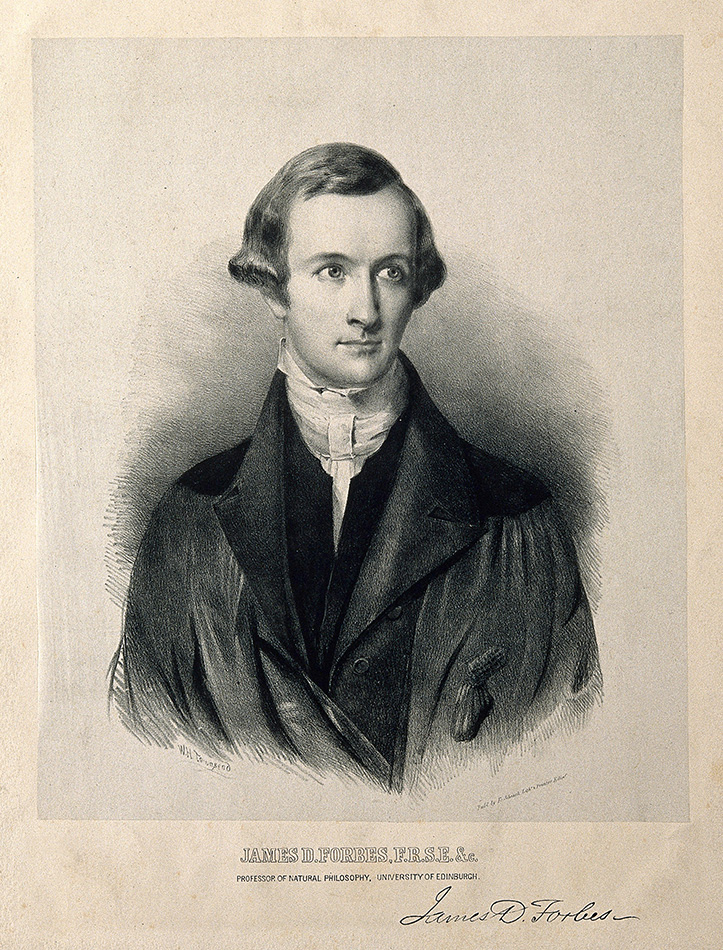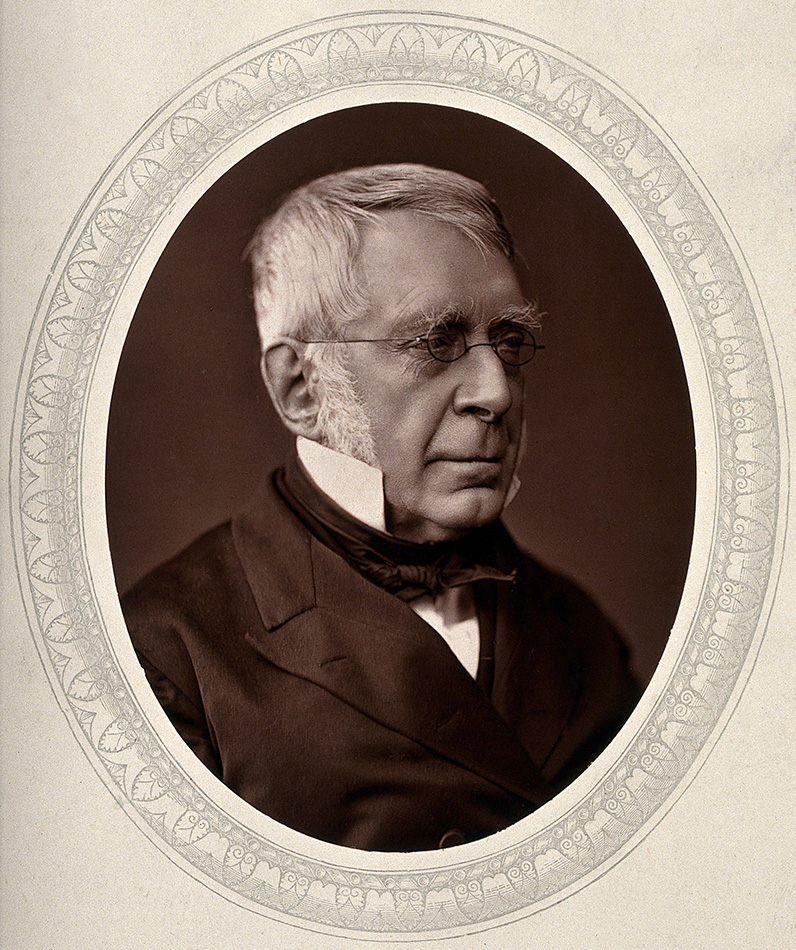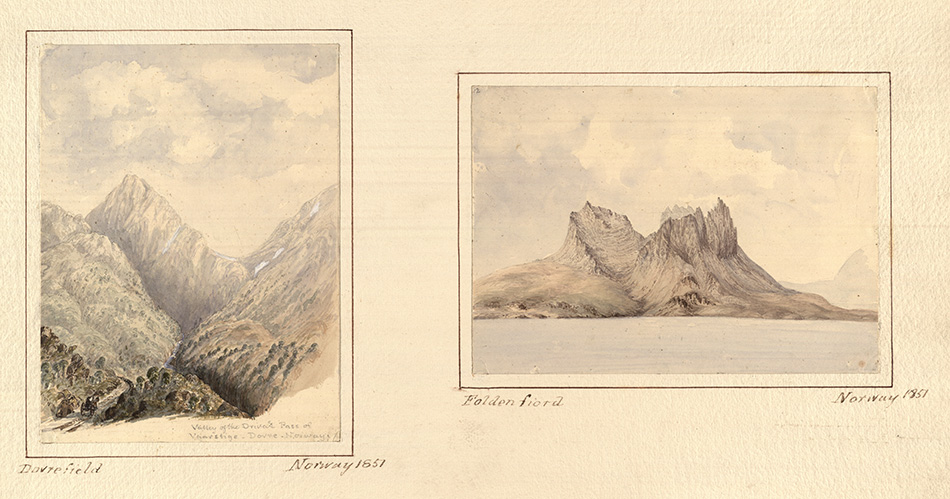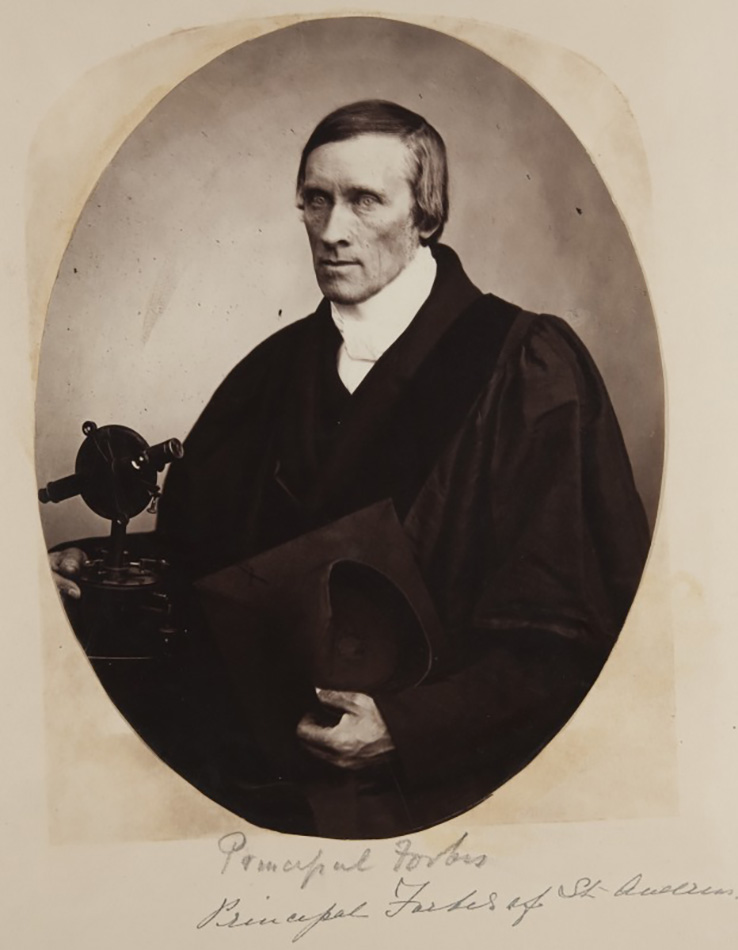“There dwells some wish in every heart”: the friendship between James David Forbes and Sir George Biddell Airy
One of our 2019 Visiting Scholars, Daniel Belteki of the University of Kent, shares with us some of his research into James David Forbes and his astronomical connections.

James David Forbes, Principal of the United College, St Andrews (1859-68) is well known as a mountaineer, for his contributions to glacier theory, and as a physicist researching meteorology and the polarisation of heat. However, his contributions to astronomy have remained relatively little explored by historians. This seems somewhat surprising as glancing through the catalogue of his personal library we find many books devoted to astronomy, with early editions of treasures such Galileo’s Difesa (1607), De revolutionibus by Nicolaus Copernicus (1543), and Newton’s Principia (1687) just to name a few. We also find magazines Forbes produced during his childhood that included numerous articles on astronomy (e.g. “The Adelphi Magazine” msdep7 – Personal papers, Box 23, no.VII/19). Moreover, his biographer notes that his first paper accepted by David Brewster’s Edinburgh Journal of Science was a paper relating to astronomical observations (Shairp, p. 35). Browsing through the correspondence among the Papers of James David Forbes (msdep7), we see names of leading nineteenth-century astronomers appearing regularly: John Herschel, Charles Piazzi Smyth and John Couch Adams. Among the leading names, Forbes was in most frequent contact with George Airy, who was the Astronomer Royal and director of the Royal Observatory Greenwich between 1835 and 1881.

The letters that survive between the two of them tell a tale of friendship arising from mutual interest in the use of models and experiments for teaching purposes through to final letters reminiscing about the active lifestyles of their younger years. In the letters they exchanged drafts of scientific papers, asked for advice on dealing with scientific controversies, shared accounts of their journeys, and discussed the use of scientific instruments. For historians researching the life of Airy, the letters also solve the practical problem of having to comb through the 12 cubic metres of records from his time at Greenwich that still survive in the archives of the Cambridge University Library. Instead, the letters between him and Forbes provide a concise overview of his life, which significantly eases the practical obstacles for any of his future biographers.
Within matters related to astronomy, the Airy-Forbes friendship had three outstanding highlights. The first one took place when Forbes decided to write a lengthy overview of the history of the Royal Observatory Greenwich for the Edinburgh Review. The letters that survive about this venture demonstrate how actively and directly involved Airy was in the writing process. He sent several publications of the Observatory to Forbes including a poster showing the rules relating to admitting visitors to the Observatory. Forbes sent at least one draft of his paper to Airy, and the Astronomer Royal commented extensively on inaccuracies about the daily labours at the Observatory and its history. The piece was eventually published in the April 1850 issue of the Edinburgh Review, and Airy was so pleased with it that he requested further copies from Forbes so that he could circulate it among his friends: “My dear Sir, A great tract (you know that I live in poetry) says “There dwells some wish in every heart” – and this might be extended as applicable to every individual subject considered by said heart. Now there dwells in my heart a wish in reference to your Observatory Review. I wish to have, if possible, two more copies; one for the Observatory Library and one to toss about among my friends” (Airy to Forbes, 6 May 1850, msdep7 – Incoming letters 1850, no.22). For historians of nineteenth-century astronomy, this story highlights Airy’s obsession with controlling the image of the Observatory even through the publications of other people.
The second episode of interest relates to the Solar Eclipse of 1851. The British Association for the Advancement of Science (Airy and Forbes were among its founding members) set up a commission charged with preparing a research programme for British observers travelling to Denmark and Norway to observe this phenomenon. Airy and Forbes were two members of this Commission, and their work resulted in the publication of recommended areas of research, guides to the sites where the Eclipse would be visible, and a map showing the shadow path of the Eclipse. Airy once again took control of the organisation and distributed among the members of the Commission various comments and suggestions for research areas. The actual expedition was a partial success as it provided additional information on the red prominences observed around the Sun. In addition, a famous first daguerreotype of the Solar Eclipse was taken at the Koenigsberg Observatory in Prussia. The accounts of the participants of the British Expedition was collected by Airy and published as part of the Memoirs of the Royal Astronomical Society. Forbes is excluded from these accounts, since bad weather intervened into his observations. However, he also used the occasion to visit the glaciers and mountains of Norway, and kept records of his journey with a few visually stunning sketches (Journal of JD Forbes, msdep7 – Journals, Box 15, no.II/28; for separate sketches see ms38081/2/6, ms38081/2/7, and ms38081/2/8). These records served as the basis for his book Norway and its Glaciers (1853), which also included a description of his unsuccessful observation of the Eclipse (pp. 112-118).

Finally, no history of Scottish astronomy should exclude a mention of Charles Piazzi Smyth, who was the Astronomer Royal for Scotland from 1846 to 1888. Forbes and Smyth crossed paths quite frequently during their lives, but their interactions never culminated in a friendship. Occasionally, they even clashed with each other. At the meeting of the British Association for the Advancement of Science held in Edinburgh in 1850, Forbes presented a paper about the use of probability theory to determine the total number of double stars. The paper included criticism of the work of the Prussian astronomer Otto Struve, who was also at the meeting as the guest of Charles Piazzi Smyth. Once Forbes presented his paper, Smyth questioned the religious belief of Forbes (based on an analogy that compared the seemingly random scattering of stars to a random scattering from a creator’s paintbrush), and further attacked Forbes for presenting material that criticised the work of a guest held in high esteem. After the meeting, Forbes mentioned to Airy that he was disappointed in Smyth for not apologising for his remarks, and Airy immediately offered to be a mediator between the two gentlemen of science (Airy to Forbes, 28 October 1850, msdep7 – Incoming letters 1850, no.93 (a,b)). In the same letter, Airy also noted that Smyth had seemed tired on the day of the meeting, which must have influenced his poor decision making. Rather than exploding into a dramatic ending, with the aid of Airy, Smyth sent a letter of apology to Forbes describing that he did not even remember making accusations against Forbes (Smyth to Forbes, 7 November 1850, msdep7 – Incoming letters 1850, no.96). Ultimately, Forbes accepted the apology and as a symbol of peace, he attended the inaugural lecture given by Smyth (Airy to Forbes, 21 November 1850, msdep7 – Incoming letters 1850, no.106).

These three episodes highlight that to provide a complete picture of Forbes and his life, it is essential to understand his active participation within the astronomical community. However, a critical analysis of his interactions with astronomers is still needed. For instance, was his friendship with Airy an immediate personal connection based on shared interests and visions, or did Forbes perhaps simply use his connection to Greenwich to further his reputation? Furthermore, despite his participation in the astronomical community, why has his reputation as an astronomer almost completely disappeared from current accounts of his life? A similar critical analysis of Airy can also be raised. Did he see Forbes as a close friend or perhaps as a practical ally in controlling the reputation of the Observatory? And what can mediating the conflict between Forbes and the Astronomer Royal for Scotland tell us about Airy’s vision for division of astronomical labour on national and international levels? Such questions remain to be answered at a future dive into the Papers of James David Forbes.
Daniel Belteki
University of Kent